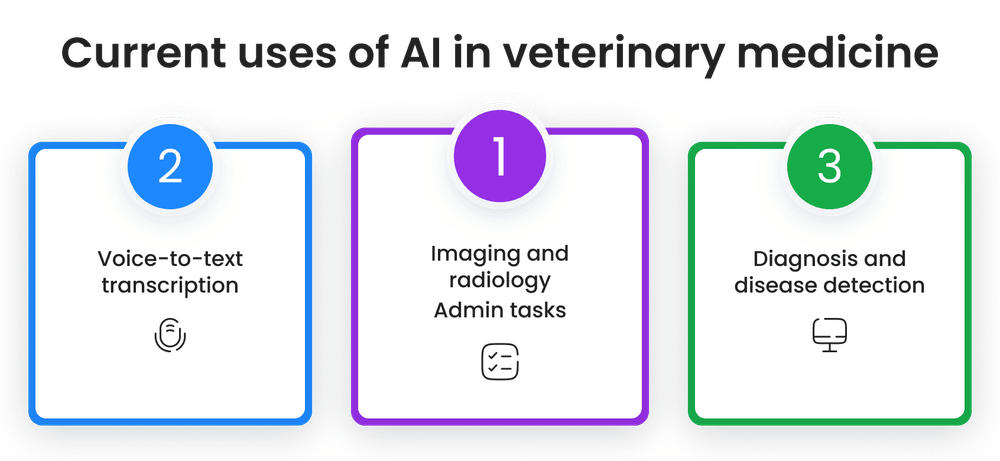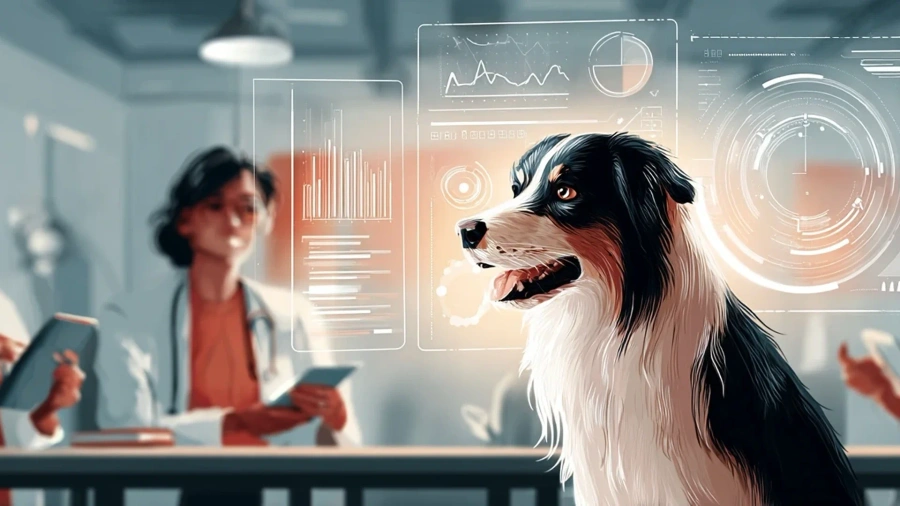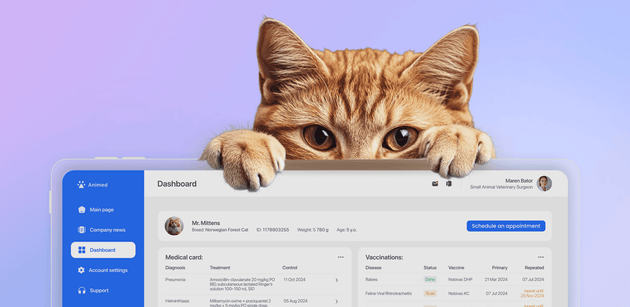A veterinary business today isn’t just competing on medical expertise – it’s competing on speed, accuracy, and operational efficiency. Missed diagnoses delay treatment and increase costs for clients and clinics alike. Manual record-keeping wastes time. Overworked staff lead to burnout. And clients expect faster, more transparent care than ever before.
Artificial intelligence isn’t replacing veterinarians. It’s addressing the real, measurable gaps in how clinics, hospitals, and labs operate. It helps save time on routine actions, improve the way data is used, and open access to tools that were once too expensive or complex.
How does AI actually work in veterinary medicine, where it’s already helping today, and what benefits does it bring to clinics and hospitals? Keep reading to discover this all.
But first, what do the numbers say?
AI in veterinary medicine, like in many other industries, has moved from concept to reality – and the data shows adoption is accelerating.
According to the American Animal Hospital Association, over 83% of veterinary professionals in the U.S. are familiar with AI tools. It’s a sign that AI is becoming part of everyday conversations in clinics, labs, and hospitals.
And many of them are not just aware – they’re already using it. Around 39% of vets surveyed reported applying AI in their practice. Among them, nearly 70% say they use these tools either daily or weekly. Is it occasional experimenting? Unlikely. It’s regular use to support routine workflows.
The same study found that familiarity with AI correlates strongly with a positive attitude toward technology. Over 65% of professionals who know how AI works are open to adopting it further.
In contrast, only 15.5% of respondents expressed resistance to using AI tools, and more than a third (38.7%) showed interest in introducing them into their processes.

Where AI is already making a difference
As we know, AI is already being used to make the work easier and smarter in many veterinary clinics. The same AAHA research highlights three top areas where AI is currently applied more often.
1. Imaging and radiology, administrative tasks
AI-powered tools help analyze X-rays, ultrasounds, and other diagnostic images faster and with fewer errors. These systems can highlight abnormalities, compare images over time, and reduce the need for second opinions.
On the admin side, AI handles scheduling, reminders, billing, and even client communication – freeing up time for staff to focus on patients, not paperwork.
2. Voice-to-text transcription
Veterinarians often juggle patient care and note-taking, and AI solves this by automatically transcribing spoken notes into medical records. It improves documentation accuracy, cuts time spent on data entry, and reduces burnout from repetitive tasks. Plus, it helps keep records up to date in real time – even during busy hours.
3. Diagnosis and disease detection
AI models can scan data from previous cases, symptoms, lab results, and even genetic profiles to assist in early diagnosis. These tools don’t replace a vet’s judgment – they offer a second opinion, catch patterns that are easy to miss, and help flag unusual conditions early. For businesses, it means more confident decision-making and improved care outcomes.

Learn how the Aristek team developed an AI-powered solution
that streamlines veterinary medical record processing. Thanks to the tool, the customer achieved the following results:
- 40% less time spent on medical records review
- 25% increase in early detection of health issues
- 30% reduction in diagnostic errors
Other popular AI use cases
If these aspects are already working smoothly in your clinic – or simply aren’t a priority – there are other areas where AI can bring real improvements. Here are five more use cases that are gaining traction across the veterinary field.
Personalized treatment planning
By analyzing patient history, lab data, breed-specific tendencies, and response patterns, AI can support tailored treatment strategies. This gives vets more context when deciding on medication, dosage, or therapy options – making care more precise and improving patient recovery rates.
Client communication and support
Chatbots and smart messaging systems can answer common client questions, handle appointment bookings, or send follow-ups – 24/7. That means less pressure on reception staff, better client engagement, and more professional service even outside of office hours.
Training and education
AI-driven platforms can simulate rare cases for training purposes, offer continuing education modules, or provide on-the-spot decision support for newer staff. It’s a smart way to upskill teams without pulling them away from their main work.
Behavior tracking and wellness monitoring
Wearables and connected devices powered by AI can track pets’ activity, sleep, eating habits, and behavioral changes. This data helps spot issues early and gives vets more information during check-ups. For pet owners, it brings peace of mind and a more connected relationship with their vet.
Inventory and supply management
AI can track inventory in real time, predict restock needs based on past usage, and even automate ordering from suppliers. This helps prevent shortages, reduce waste, and cut costs – especially in busy clinics with fast-moving supplies.
How much would it cost to build solutions like these?
Use our free online calculator to get a quick estimation.
So, is AI worth it?
Let’s flip the question: What exactly does a veterinary business gain from implementing AI? It’s easy to say “increased efficiency” – but how does that actually play out in day-to-day work, on balance sheets, and in the long run?
Here’s a closer look at the real-world benefits AI brings to the table.
More time, less pressure
Over 60% of veterinary professionals say AI helps improve productivity and save time. By handling routine tasks like scheduling, data entry, or initial screenings, AI allows teams to focus on what matters most – patient care.
In the short term, that means fewer overtime hours and less stress. In the long run, it creates a more manageable, efficient workflow that’s easier to scale as your business grows.
Happier, more focused teams
When AI reduces the admin workload – which 56.1% of professionals named as a top benefit – teams feel the difference. Staff aren’t drowning in repetitive tasks or stuck in systems that slow them down.
According to the same research, 37.6% reported improved well-being and job satisfaction as a result. Retaining skilled workers becomes easier, and burnout rates go down.
Smarter clinical decisions
AI doesn’t replace a vet’s judgment – it supports it. From diagnostics to treatment planning, smart tools can flag anomalies, compare data, and offer insight that may otherwise go unnoticed.
37% of those surveyed said AI helps with clinical decision-making. For businesses, that translates to fewer errors, better outcomes, and stronger trust from clients.
Better client communication
Over 41% of respondents believe AI improves client education. Whether it’s chatbots that respond instantly or tools that help explain diagnoses in simple terms, AI raises the standard of communication.
This builds stronger relationships with pet owners, improves transparency, and increases client loyalty – a key factor in long-term revenue stability.
Faster, more accurate records
AI-assisted documentation is already gaining ground, with 38.6% pointing to its value in writing patient records. That means no more scrambling to fill in gaps or wasting time deciphering rushed notes. It improves consistency and speeds up information sharing – especially critical in emergency care or multi-vet clinics.
A real business advantage
AI isn’t just about doing things better – it’s about doing more. 57.7% believe AI can help increase the number of patients they serve, while 73% link it to better resource allocation. That’s time, money, and manpower used more effectively.
And with over half of professionals seeing it as a competitive advantage, the message is clear: AI isn’t optional for those who want to stay ahead – it’s the next smart step.

Still have doubts? You’re not the only one
You’re not the only one. While AI is gaining traction in veterinary medicine, it’s far from universally embraced – and for good reason.
According to the American Animal Hospital Association, nearly 46% of veterinary professionals feel uncertain about adopting AI in their practice. So, what’s holding them back?
The top concerns are:
- Reliability and accuracy – cited by 70.3% of respondents, this is the most common concern. When patient health is on the line, there’s little room for error, and trust in automated systems isn’t built overnight.
- Data security and privacy – over 53% worry about sensitive information being mishandled or exposed. With more digital tools in play, practices are right to ask how their data is stored, protected, and used.
- Lack of training and knowledge – 42.9% said they don’t feel equipped to use AI tools effectively. It’s not just about having the software – it’s about knowing how to apply it with confidence.
Still, the outlook isn’t bleak. The same research shows that more than half of the respondents believe that real-life success stories, user-friendly training, and seamless integration with existing systems could help change the game. The hesitation is real – but so is the progress.
How Aristek can help
AI isn’t taking over veterinary medicine overnight – but it is becoming part of it, step by step. Clinics and hospitals can choose to gradually adopt new tools that solve specific challenges – or risk being slowed down by outdated workflows.
We help improve veterinary businesses at every stage of the care cycle: from client communication and appointment scheduling, to diagnostics and testing, treatment planning, invoicing, and post-visit monitoring. We also help you unlock better analytics and reporting – whether with AI or other advanced technologies.
Every clinic is different. That’s why we take the time to understand your unique needs and offer solutions that are practical, secure, and scalable.
Book a free consultation with our team to explore what’s possible – no pressure, just honest insights into what technology can really do for your practice.





